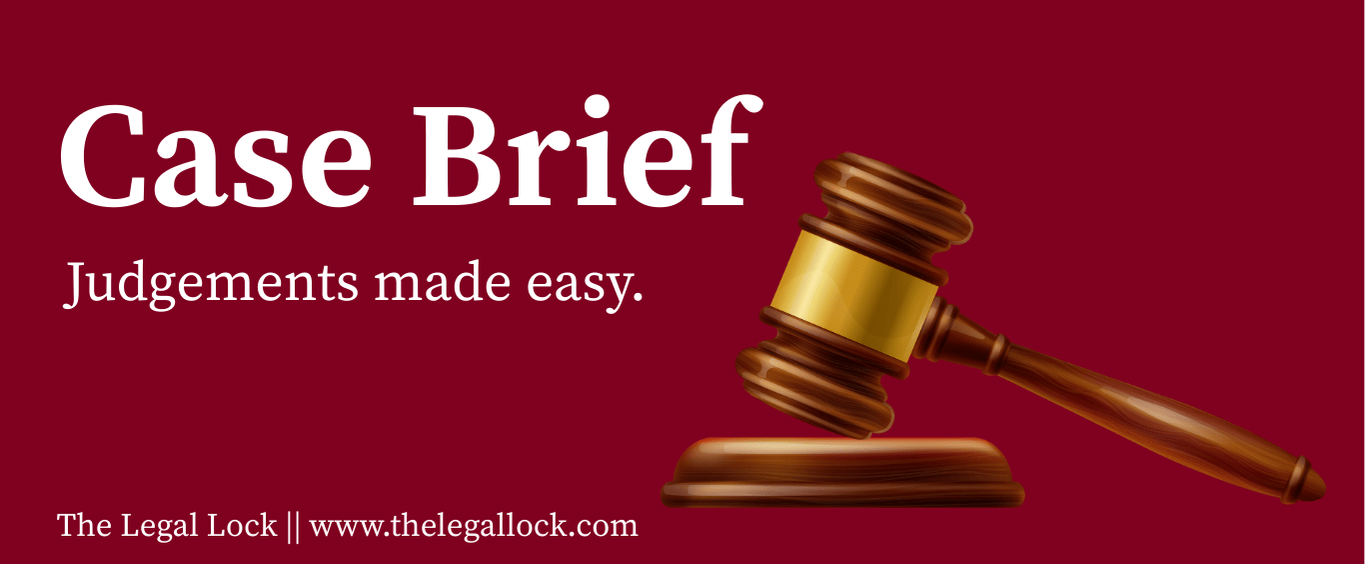Case Brief: Sajjan Singh v. State of Rajasthan

| CASE NAME | SAJJAN SINGH VS STATE OF RAJASTHAN |
| CITATION | AIR 1965 SC 845 |
| COURT | SUPREME COURT OF INDIA |
| BENCH | CHIEF JUSTICE P.B. GAJENDRAGADKAR AND JUSTICES K.N. WANCHOO, M. HIDAYATULLAH, J.R. MUDHOLKAR, RAGHUBAR DAYAL |
| PETITIONERS | SAJJAN SINGH |
| RESPONDENTS | STATE OF RAJASTHAN |
| DECIDED ON | WRIT PETITION 31 OF 1964, 31 MARCH 1965 |
INTRODUCTION
One of the highest laws of the nation in India is the Constitution. That being said, despite being a contentious issue since Indian independence, it has not received the same level of attention. This is a result of the revisions made to keep it current with the changes occurring in Indian society. According to Article 368 of the Constitution, the legislature is granted this authority. 104 modifications to the Indian Constitution have been made between 1951 and 2020 under the purview of this right. A number of instances have been brought out by the public contesting these revisions on the grounds that their fundamental rights have been violated. In 1965, the Indian Supreme Court heard the case of Sajjan Singh v. State of Rajasthan.
In this case, the constitutionality of the 26th Amendment to the Constitution, which eliminated the princely rights and privy purses of the erstwhile princely states, was contested. In the Supreme Court, Sajjan Singh, the king of the princely state of Ratlam, contested the 26th Amendment Act’s legality, claiming that it infringed upon his fundamental rights as protected by the Indian Constitution.
BACKGROUND OF THE CASE
The case of Shankari Prasad v. Union of India involved a challenge to the First Constitutional (Amendment) Act, 1951. This amendment limited a person’s right to property by adding Articles 31-A and 31-B to the constitution. It was also specified that laws covered under the Constitution’s Ninth Schedule would not be subject to judicial review. The Shankari Prasad case contested the amendment, arguing that since the Fundamental Rights are an essential component of the Constitution, they cannot be changed. In the end, the Supreme Court decided that the contested change was constitutionally lawful by interpreting Articles 13 and 368 in a harmonious manner.
FACTS
Prior to its eventual assimilation into the Indian Union, Ratlam was a princely state ruled by Sajjan Singh. Sajjan Singh gained a number of rights and functions via an agreement he signed in 1949 with the Indian government, including the annual Privy Purse. The erstwhile princely states’ rulers lost their privy purses and royal privileges when the Constitution (26th Amendment) Act was passed in 1954. Taking the position that it infringed upon his fundamental rights as protected by the Indian Constitution, Sajjan Singh challenged the 26th Amendment Act’s legality before the Supreme Court. Therefore, the main question put to the Apex Court was whether changing fundamental rights amounted to changing the Constitution or rewriting a portion of it, and if the latter, whether it would put it under the purview of Article 368.
Thus, the Doctrine of Pith and Substance was employed in order to make a judicial and equitable decision on this issue. Though it did not succeed in safeguarding Fundamental Rights, the Apex Court played a vital role in formulating the Basic Structure Doctrine. The power of the Parliament to amend the Indian Constitution, especially in relation to the Fundamental Rights, was a controversial topic that this case highlighted. Part III of the Constitution, which contained the Fundamental Rights, was the only place in which the Parliament was able to change the Constitution; therefore, the Supreme Court overturned its decision in the Shankari Prasad case, raising the issue once more.
ISSUES
- Is it more appropriate to rewrite a section of the Constitution or change a basic aspect of the document, and if so, would that fall under the jurisdiction of Article 368?
ARGUMENTS OF BOTH SIDES
According to Sajjan Singh, the petitioner, the 26th Amendment Act infringed his fundamental rights as guaranteed by the Indian Constitution by doing away with the princely privileges and privy purses of the rulers of the former princely states. Breach of Article 14: The petitioner argued that the basic right to equality protected by Article 14 of the Constitution was breached by the 26th Amendment Act. Because it solely impacted a particular class of people, the petitioner claimed that the removal of the privy purses held by the erstwhile princely state rulers was discriminatory and arbitrary.
A basic right to property protected by Article 19(1)(f) of the Constitution was allegedly violated by the petitioner’s claim that the privy purses were abolished. According to the petition, the privy purses belonged to the previous rulers and their removal would be equivalent to taking something away from them without paying for it.A basic right to property protected by Article 31 of the Constitution was allegedly breached, according to the petitioner, by the abolition of privy purses.
The petition claimed that the privy purses belonged to the previous monarchs and that eliminating them would be equivalent to taking them forcibly and paying no money in return. Non-justiciability of the Agreement: The petitioner argued that the accord, which gave the Indian government and the former rulers specific rights and powers, was a legitimate and binding contract. The petitioner contended that as the agreement concerned executive policy, the courts were not entitled to scrutinize it.
Incompatible with both the Indian Constitution and democratic ideals were the royal privileges and privy purses.It was discriminatory and went against the idea of equality before the law since the advantages were based on the ruler’s birth.Not by the Indian Constitution, but rather by treaties with the British administration, princely privileges and privy purses were awarded.Because of this, the Indian government was under no obligation to maintain these benefits following the princely states’ incorporation into the Indian Union.A prerequisite for the integration of the princely states into the Indian Union was the elimination of the privy purses and princely privileges. In order to prevent anyone from receiving special treatment based just on where they were born, the Indian government had to make sure that all of its residents were treated equally.
The reply further maintained that the Indian Constitution’s fundamental rights were not violated by the removal of privy purses and royal privileges. Since the former rulers of the princely states did not view these privileges as rights in the first place, their elimination did not violate any of their fundamental rights.
JUDGEMENT
The Court determined that the princely benefits and privy purses were incompatible with India’s Constitution, which forbids discrimination based on a person’s birth and ensures equality before the law. The princely monarchs’ privileges and powers were conferred by treaties with the British government, the Court further noted, and they had no particular claim to them based alone on their birth. As part of the process of merging the princely states into the Indian Union, the Court additionally decided that the Indian government was justified in removing the privy purses and princely privileges. As these were never regarded as rights in the first place, the Court further found that the elimination of privy purses and princely privileges did not infringe the fundamental rights protected by the Indian Constitution. The Supreme Court of India maintained the legality of the 26th Amendment Act, which did away with the princely rights and private wealth of the former princely states. The Court ruled that the privy purses and princely advantages were against Indian democracy and the Constitution, which forbids discrimination, based on a person’s birth and ensures equality before the law. It was noted by the Court that the princely rulers’ rights and powers were conferred through treaties with the British government, and that they had no particular claim to them simply by virtue of their birth.
ANALYSIS
Judge M. Hidayatullah’s dissenting opinion forced the courts and legislators to reexamine the rulings in the cases of Sajjan Singh v. State of Rajasthan and Shankari Prasad v. Union of India. Future cases, such as Golaknath v. State of Punjab and the notorious Kesavananda Bharati Case, were filed on the basis of the aforementioned opinion. The Preamble and an individual’s Fundamental Rights are considered to be components of the fundamental framework of the Indian Constitution, as the Supreme Court of India ultimately determined in the Kesavananda Bharati Case of 1973. This important ruling established the renowned Basic Structure Doctrine, which aids in determining whether all legislation currently in effect in India are constitutionally permissible. The Indian government’s choice to do away with the princely rights and private wealth of the former princely states was affirmed by the Supreme Court’s ruling. It was this judgement that opened the door for a more democratic and egalitarian society and was essential in the princely states’ assimilation into the Indian Union. In its ruling, the Supreme Court established the primacy of the Constitution over all other laws and agreements, upholding democratic ideals of equality and non-discrimination. In relation to the former princely state rulers, this improved the Union government’s position.






